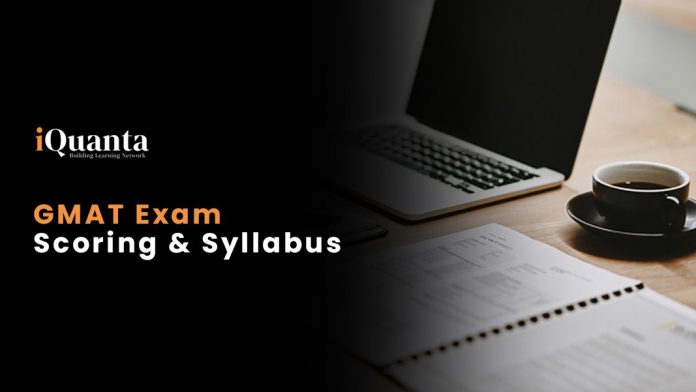The GMAT exam is a common entrance test for admission to business schools across the globe. It is a computer test in which every individual gets a different set of questions chosen by the computer according to their ability. GMAT syllabus consists of four sections. Let’s understand each section in detail. Before starting to study for the test, the candidate should know exactly what will be on the test.
GMAT Focus Edition 2024
GMAC has launched new ‘GMAT Focus Edition’ on February, 2024. The applicants can register for the test through the GMAC official website www.gmac.com. The test duration is of 2 hours 15 minutes. You can check out the changes in syllabus via this link.
GMAT Focus Edition- Syllabus – Section-wise
The new GMAT Focus Edition is inclusive of three sections i.e. Quantitative Reasoning, Verbal Reasoning and Data Insights. The exam duration is of 2- hours and 15- minutes. The total number of questions to be attempted- 64.
|
Section |
No. of Questions |
Syllabus |
Time Duration |
|
Quantitative Reasoning |
21 |
|
45 |
|
Verbal Reasoning |
23 |
|
45 |
|
Data Insights |
20 |
|
45 |
GMAT Syllabus
Many MBA aspirants across the globe appear for the GMAT exam. It is the basis for getting them into their dream business school. This is a 3-hours, 7-minutes test with a minimum score of 805 points and is split into four parts:
- Quantitative Reasoning
- Verbal Reasoning
- Analytical Writing Assessment
- Integrated Reasoning
GMAT Syllabus – Section-wise
Quantitative Reasoning
The quantitative reasoning section of the GMAT tests a candidate’s ability to solve math problems and understand graphs. It has two parts with multiple-choice questions:
| Problem-Solving |
| Data Sufficiency |
To do well on this section, you need to know basic maths, elementary algebra, and common geometry ideas. Refer to the table below for the complete quant syllabus:
| Arithmetic | Algebra | |
| Number Properties | Functions | |
| Multiples & Factors | Exponents | |
| Decimals | Statistics | |
| Fractions | Arithmetic | |
| Average | Algebraic Expressions & Equations | |
| Percentage | Permutation & Combination | |
| Speed, Time, Distance | ||
| Simple & Compound Interest | ||
| Ratio & Proportion | ||
| Probability |
Verbal Reasoning
The verbal reasoning section of the GMAT tests how well a candidate can read, understand, reason, and evaluate logically the arguments in passages. It consists of three parts, each with numerous multiple-choice questions:
Get the GMAT Online Coaching by iQuanta
| Critical Reasoning |
| Sentence Correction |
| Reading Comprehension |
Critical Reasoning
It is the test to analyze an individual’s ability to reason logically through an argument and answer objectively, while avoiding personal opinion when attempting to answer the question.
Reading Comprehension
This test is designed to evaluate the aspirant’s ability to read and comprehend the concepts quickly. The given passages are generally between 200–350 words, and have multiple questions to answer. The candidates are evaluated on the following reading skills:
| Interpretation of the information in the given passages |
| Understanding the main idea |
| forming a logical structure |
| Following the development of quantitative concepts |
Sentence Correction
This part is a single-sentence correction question, where the words with errors are underlined. It measures an individual’s language proficiency by testing:
| Their efficiency in grammatically and structurally correcting the sentence was outstanding. |
| Their understanding of effective and concise expression of an idea. |
The areas covered in GMAT Verbal Reasoning are:
| Reading unfamiliar passages |
| Critical reasoning |
| Rhetorical sentence construction |
| Finding omissions or errors in sentences |
| Subject vs verb agreement |
| Modifiers |
| Countable and uncountable |
| Parallelism |
Analytical Writing Assessment
The GMAT analytical writing assessment section is a test of your writing style. You are asked only one question in this section. In only 30 minutes, you have to understand, analyze, think quickly and critically, and write the essay using facts and examples that make sense.
Integrated Reasoning
In the integrated reasoning section of the GMAT, you are tested on your ability to understand and evaluate information from different sources, and in different formats, such as pictures, words, and numbers. This test checks how well you can evaluate facts and numbers that are shown in graphs and tables.
Since the GMAT is an adaptive test, it changes based on how well each person does on it. You can check your score immediately after giving the test. If you are not satisfied with your score, you get a chance to re-attempt it only after 16 calendar days. The scores are valid for five years from the date of the examination.
This exam can be taken five times per year, and a lifetime limit of eight GMAT attempts.
You will also get an email from GMAC 20 days after taking the GMAT with instructions on how to access your online scores when your official scores are ready. The candidates have to submit their scorecards to the business school as admission criteria.
GMAT Exam Scoring
The GMAT exam score is calculated on a fixed scale that is visible on the scorecard. Check out the table below to understand the GMAT scoring system:
| Section | Score Range | Score Calculation Basis |
| Quantitative & Verbal Reasoning | 6-51 | Both of these sections are item-adaptive. High scores are granted on the basis of: No. of questions answered No. of correct answers Level of difficulty of answers |
| Integrated Reasoning | 1-8 | This section is scored on the basis of the number of questions answered correctly. |
| Analytical Writing Assessment | 0.0-6.0 | This section is marked by a machine algorithm and a professional essay reader. |
Average test takers score between 400 and 600, while the minimum score for the GMAT is 205 and the maximum is 805. A 700-plus score is easy to get with the right guidance, apt study material, and study support.
For comprehensive guidance and to enroll for iQuanta’s newly launched GMAT Course, visit the link below.

For daily practice questions and 24*7 doubt clarification, join the group linked below





